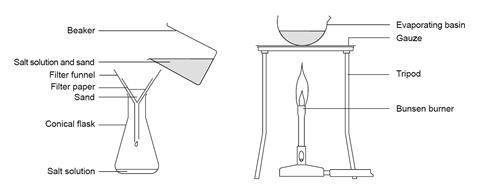How Do You Separate Sand And Water
In this form experiment, students split a mixture of sand and common salt, illustrating the fundamental means of separating a mixture of an insoluble material from i that is soluble
This is a very straightforward experiment. It can be carried out individually or in groups of two. Pupils must stand up during heating activities and beware of hot salt spitting when evaporation is nearly complete.
Equipment
Apparatus
- Eye protection
- Beaker, 250 cm3
- Glass stirring rod
- Filter funnel
- Filter newspaper
- Conical flask, 250 cm3
- Evaporating basin
- Bunsen burner
- Heat resistant mat
- Tripod
- Gauze
Chemicals
- Mixture of sand and sodium chloride (salt), about six–vii grand per grouping of students (a suitable sand–salt mixture should contain approximately xx% salt by mass)
Health, safety and technical notes
- Wear centre protection throughout this experiment.
- Pupils must stand up up during heating activities and beware of hot common salt spitting when evaporation is nigh complete.
- Sodium chloride (eg table common salt), NaCl(s) - meet CLEAPSS Hazcard HC047b.
Procedure
- Cascade the sand–common salt mixture into the chalice so that it just covers the base.
- Add virtually 50 cm3 of h2o, or add h2o until the beaker is most one-5th full.
- Stir the mixture gently for a few minutes.
- Filter the mixture into a conical flask.
- Pour the filtrate into an evaporating basin.
- Heat the table salt solution gently until it starts to decrepitate (spit). CARE: Go on heart protection on and practise non go also close.
- Turn off the Bunsen burner and permit the damp salt dry in the dish.

Pedagogy notes
If desired, the experiment can be extended to isolate dry out samples of sand and salt. To do this, the damp sand in the filter newspaper tin can exist transferred to some other canvass of dry out filter paper, and, by folding and dabbing, the sample can be dried. If necessary, some other piece of filter paper can be used.
Students frequently like to present their specimens in small bottles for approval, so a spatula could exist used to achieve this. While the outset student of a pair is transferring the sand, the other can be scraping the dried salt from the evaporating dish and transferring it to another specimen bottle.
If this extension is carried out, the students should be encouraged to label the bottles. They should be told that all samples prepared in this mode need to be labelled, even if in this case, it should be obvious which substance is which.
Educatee questions
- Why tin can sand and common salt be separated using this experiment?
- Why is the common salt, sand and water mixture stirred in step 3?
- Why is the table salt solution heated in pace six?
- How might the concluding traces of h2o exist removed from your samples to ensure that they are totally dry?
- Give ii reasons why the sand you have obtained might nevertheless be contaminated with salt.
- How could you adapt your experiment to obtain a purer sample of sand?
- Requite ii reasons why the common salt you have obtained might still be contaminated with sand.
- How could you adapt your experiment to obtain a purer sample of salt?
Main science educational activity notes
If you teach primary science, the following information is designed to assistance you lot utilize this resource.
Skill development
Children will develop their working scientifically skills past:
- Drawing conclusions and raising further questions that could be investigated, based on their data and observations.
- Using appropriate scientific language and ideas to explicate, evaluate and communicate their methods and findings.
Learning outcomes
Children will:
- Discover that some materials will dissolve in liquid to form a solution.
- Describe how to recover a substance from a solution.
- Utilize noesis of solids, liquids and gases to make up one's mind how mixtures might exist separated, including through filtering, sieving and evaporating.
- Demonstrate that dissolving, mixing and changes of country are reversible changes.
Concepts supported
Children volition larn:
- That there are diverse techniques that tin be used to separate unlike mixtures.
- That dissolving is a reversible reaction.
- That not all solids are soluble.
- That the rate of dissolving can be affected by diverse factors.
- That melting and dissolving are not the same process.
Suggested activeness apply
This activity can be used equally a whole-form investigation, with children working in modest groups or pairs to await at how to separate the salt and sand. This could provide a stimulus for further investigations looking at how to separate other mixtures of solids, either of different particle sizes or by solubility.
Practical considerations
Primary schools often don't have Bunsen burners, then feasible alternatives need to exist sourced. Similarly, it may be difficult to source the equipment needed to evaporate h2o to recover the dissolved salt. Head stands and tea lights can work well equally possible alternatives.
When carrying out this activity be aware that some insoluble solids are able to form suspensions. This is where the particles appear to have dissolved, when in fact they accept been spread out throughout the liquid. A good indicator that a interruption has formed is that the liquid will get cloudy or the particles can be heard scraping as the mixture is stirred.
The layout of this activeness is very prescriptive equally the procedure is fix out on a pace by stride basis. An open claiming activity, with children working in small groups and devising their own methods, would extend the children's thinking. Different groups' suggestions could be compared and evaluated every bit a class.
How Do You Separate Sand And Water,
Source: https://edu.rsc.org/experiments/separating-sand-and-salt-by-filtering-and-evaporation/386.article
Posted by: dodsonbeele1989.blogspot.com


0 Response to "How Do You Separate Sand And Water"
Post a Comment